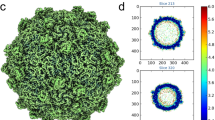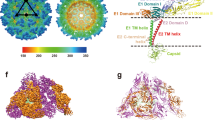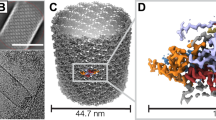Abstract
BLUETONGUE virus (BTV), a representative of the orbivirus genus of the Reoviridae, is considerably larger (at 80 nm across), and structurally more complex, than any virus for which we have comprehensive structural information. Orbiviruses infect mammal-ian hosts through insect vectors and cause economically important diseases of domesticated animals1. They possess a segmented double-stranded RNA genome within a capsid composed of four major types of polypeptide chains1. An outer layer of VP2 and VPS is removed as the virus enters the target cell, to leave an intact core within the cell. This core is 70 nm across and composed of 780 copies of VP7 (Mr 38K) that, as trimers, form 260 'bristly' capsomeres clothing an inner scaffold constructed from VP3 (Mr103K) 2. We report here the crystal structure of VP7 from BTV serotype 10, which reveals a molecular architecture not seen previously in viral structural proteins. Each subunit consists of two domains, one a β-sandwich, the other a bundle of α-helices, and a short carboxy-terminal arm which might tie trimers together dur-ing capsid formation. A concentration of methionine residues at the core of the molecule could provide plasticity, relieving structural mismatches during assembly.
This is a preview of subscription content, access via your institution
Access options
Subscribe to this journal
Receive 51 print issues and online access
$199.00 per year
only $3.90 per issue
Buy this article
- Purchase on Springer Link
- Instant access to full article PDF
Prices may be subject to local taxes which are calculated during checkout
Similar content being viewed by others
References
Knudson, E. L. & Monath, T. P. in Virology (eds Fields, B. N. & Knipe, D. M.) 1405–1433 (Raven, New York, 1990).
Roy, R., Marshall, J. J. A. & French, T. J. in Bluetongue Virus (eds Roy, P. & Gorman, B. M.) 43–87 (Springer, Heidelberg, 1990).
Stuart, D. I. Curr. Opin. struct. Biol. 3, 167–174 (1993).
Wilson, I. A., Skehel, J. J. & Wiley, D, C. Nature 289, 366–373 (1981).
Rossmann, M. G. et al. J. molec. Biol. 165, 711–736 (1983).
Hough, E. et al. Nature 338, 357–360 (1989).
Fisher, A. J. & Johnson, J. E. Nature 361, 176–179 (1993).
Janin, J., Miller, S. & Chothia, C. J. molec. Biol. 204, 155–164 (1988).
Oliveira, M. A. et al. Structure 1, 51–68 (1993).
Le Blois, H. & Roy, P. J. Virol. 67, 353–359 (1993).
Liddington, R. C. et al. Nature 354, 278–284 (1991).
Hewat, E. A., Booth, T. F. & Roy, P. Virology 189, 10–20 (1992).
Georgiadis, M. M. et al. Science 257, 1653–1659 (1992).
Creighton, T. E. Proteins (Freeman, New York, 1993).
Eaton, B. T. et al. Virology 180, 687–696 (1991).
Mertens, P. P. C., Burroughs, J. N. & Mellor, P. S. Infection of culicoides Vector Species by Different Orbivirus Particle Types (International Congress of Virology, 1993).
Logan, D. et al. Nature 362, 566–568 (1993).
Wistow, G. et al. J. molec Biol. 170, 175–202 (1983).
Mcpherson, A. J. Preparation and Analysis of Protein Crystals (Wiley, New York, 1982).
Otwinowski, Z. in Data Collection and Processing (eds Saywer, L., Isaacs, N. & Bailey, S.) 56–62 (SERC, Darsbury Laboratory, Warrington, UK, 1993).
Jones, Y. & Stuart, D. I. in Isomorphous Replacement and Anomolous Scattering (eds Wolf, W., Evans, P. R. & Leslie, A. G. W.) 39–48 (SERC, Daresbury Laboratory, Warrington, UK, 1991).
Otwinowski, Z., in Isomorphous Replacement and Anomolous Scattering (eds Wolf, W., Evans, P. R. & Leslie, A, G. W.) 80–86 (SERC, Daresbury Laboratory, Warrington, UK, 1991).
CCP4 Acta crystallogr. D50, 760–763 (1994).
Read, R. J. Acta crystallogr. A42, 140–149 (1986).
Brunger, A. T. XPLOR Version 3.0. (Yale Univ. Press, New Haven, 1992).
Jones, T. A. Meth. Enzym. 115, 157–171 (1985).
Prasad, B. V. V., Yamaguchi, S. & Roy, P. J. Virol. 66, 2135–2142 (1992).
Kraulis, P. J. J. appl. Crystallogr. 24, 946–950 (1991).
Merritt, E. A. & Murphy, M. E. P. Acta crystallogr. D50, 869–873 (1994).
Stuart, D. I., Levine, M., Muirhead, H. & Stammers, D. K. J. molec. Biol. 134, 109–142 (1979).
Author information
Authors and Affiliations
Rights and permissions
About this article
Cite this article
Grimes, J., Basak, A., Roy, P. et al. The crystal structure of bluetongue virus VP7. Nature 373, 167–170 (1995). https://doi.org/10.1038/373167a0
Received:
Accepted:
Issue Date:
DOI: https://doi.org/10.1038/373167a0
This article is cited by
-
Biophysical characterization and crystal structure of the Feline Immunodeficiency Virus p15 matrix protein
Retrovirology (2013)
-
Functional Mapping of Bluetongue Virus Proteins and Their Interactions with Host Proteins During Virus Replication
Cell Biochemistry and Biophysics (2008)
-
The molecular organization of cypovirus polyhedra
Nature (2007)
-
Biggest virus molecular structure yet!
Nature Structural Biology (1998)
-
The atomic structure of the bluetongue virus core
Nature (1998)
Comments
By submitting a comment you agree to abide by our Terms and Community Guidelines. If you find something abusive or that does not comply with our terms or guidelines please flag it as inappropriate.



